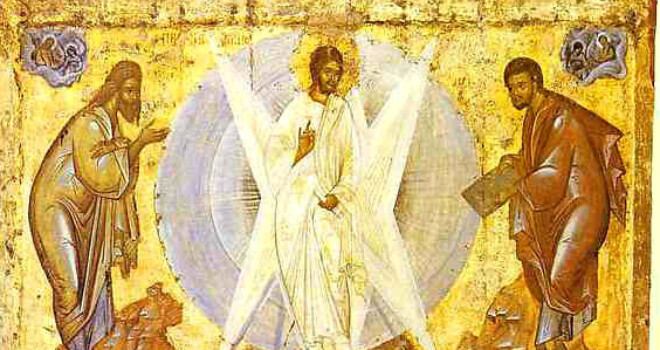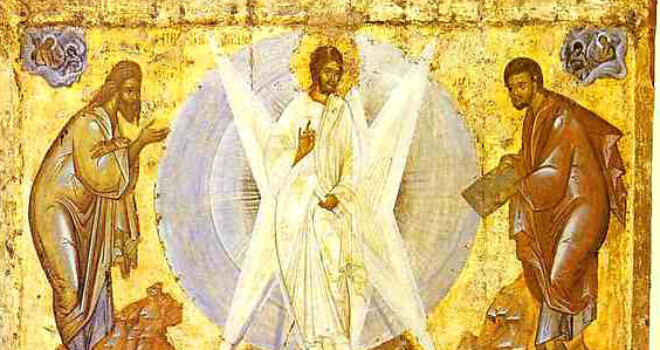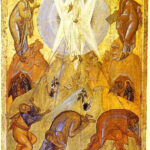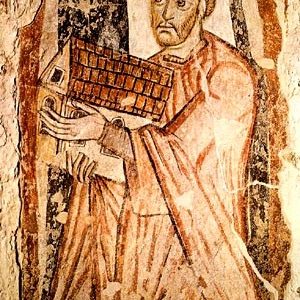Viewing and pondering sacred art, engaging in vizio divina, offers the faithful a great way to meditate more deeply on the life of Jesus Christ and the mystery of salvation. This series of articles will highlight several pieces of art related to the season of Lent, specifically the Gospel readings for each week. Each of these pieces of art allows us to reflect on the transformation to which our Lord calls us during this penitential season, and to bring the realities of these biblical episodes into our own lives.
Eastern Christianity (the eastern Catholic rites and Orthodox churches) employs iconography as a foundational expression of faith and spirituality. Robert L. Wilken, an esteemed historian of early Christianity, writes: “The veneration of icons is the church’s most palpable way of proclaiming that God appeared in human flesh in the person of Jesus Christ. … What is depicted in the image of Christ is neither simply the human Jesus nor the invisible God, but the image of God become flesh.”* Understanding this basic truth about the incarnational principle should cause the western Church to appreciate and benefit from this rich art form as well.
On the Second Sunday of Lent each year, the faithful hear and receive the Gospel episode of the Transfiguration. Since we have recently dealt with the Transfiguration in this series, it seems appropriate to examine this event through a mystical medium that stands outside of our usual experience. The Icon of Theophanes the Greek, which was produced in Russia in the late-fourteenth century, offers a great opportunity to enter more deeply into this mystery during this season of transformation.
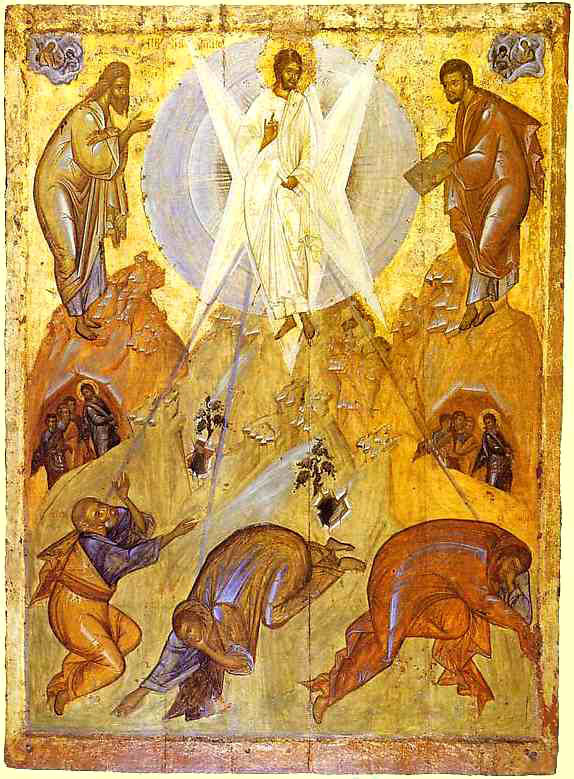
The biblical narrative tells us that Jesus took these three apostles “up a high mountain by themselves” (Mt. 17:1). This detail is reflected in small insets on both sides of Mount Tabor. On the left-hand side, the foursome walks up the mountain; and on the right-hand side, they walk downward (cf. Mt. 17:9). On the ascent, the apostles look quite tepid, perhaps a little unsure about what they might experience; and on the descent they look a bit perplexed about what has just been revealed to them. Viewers, even the most ardent disciples of Jesus might identify with both feelings. Whether in Lent or any other time, have I been fearful of what the Lord might reveal to me? After some revelation from the Lord, has it taken me some great length of time to process and assimilate that reality?
In the top quadrant on each side of the icon, we see the two figures who were “conversing with Jesus” in the biblical scene (Mt. 17:3). On the right, Moses stands on a mountain peak and holds a book. The book certainly represents Torah, and the mountain might be significant of Mount Sinai, from whence the Decalogue was revealed. Moses bows toward Jesus with crossed feet. On the left is Elijah, representing the entire line of Old Testament prophets. The mountain on which he stands might signify Mount Carmel, which was the sight of confrontation between Elijah and the false prophets of Baal (see 1 Kg. 18). Elijah bows toward Jesus with crossed arms. With each tiny detail, these figures illustrate the Christian understanding that Jesus is the culmination, the fulfillment, of the Old Testament Torah and the prophets of the old covenants. As a Christian, do I engage with the history and message of the Old Testament? Do I realize that, while it has been fulfilled, the Old Testament still retains its value for leading me into deeper relationship with God?
Both of those significant Old Testament figures engage with Jesus, and they point the viewer toward the One who is the focal point of this icon. The Gospel tells us that Jesus “was transfigured before them,” and that “his face shone like the sun and his clothes became white as light” (Mt. 17:2). This is reflected in the fact that Jesus is enveloped in white, with burst of light behind him, like the explosion of a star. One might ask: Do I think of Jesus as “the radiance of the glory of God” (Heb. 1:3 ESV)? Have I recognized that Jesus wants me to be transfigured by that same divine light? How can I participate in Jesus’ dazzling radiance?
Behind the dazzling white mantle of Our Lord, there is a blue circle, a color and shape that are frequently used in iconography to represent heavenly realities. The fact that Jesus is at the center of this shape indicates that Eternity breaks into time in a unique and powerful way in the Transfiguration, specifically in the Incarnate Lord. From the “beloved Son” with whom the Father is well pleased (Mt. 17:5), rays of divine grace emanate to other parts of the scene, including onto Peter, James, and John. These rays indicate the transformation that can take place on the earth and in human hearts. Have I allowed God’s grace to shine into my life, including in unexpected ways? Do I notice the ways that God’s glory transfigures creation as well?
Another detail of the icon that indicates to us how astonishing this event was is the positions of the apostles. They are all lying prostrate. Only the apostle on the left, Simon Peter, looks toward Jesus. The apostle on the right, probably St. John, covers his face while the apostle in the middle, St. James, looks as though he is trying to crawl away quickly. Perhaps each of us can notice all of these reactions when divine grace comes to us. Do I turn away in fear or confusion? Do I shield my eyes due to the radiant light, or in an effort not to see? Am I drawn to gaze more fully at the Lord?
One final theme is worth noting. This icon is full of brilliant colors, but all of them rest upon a background of gold. In iconography, the use of gold suggests realities that are not of this earth, those that are divine and incorruptible. In our own endeavors to live Lent, it is necessary for us to realize that all of our activities and sacrifices flow from and are ordered toward our relationship with God. Do I see my relationship with God as the very foundation of every beautiful or challenging thing that happens in my life? Do I go about life seemingly at random, or do I allow my daily actions to arise out of my relationship with God? The goodness and beauty of my life comes from a real and ongoing relationship with the Lord, just like the beautiful colors of icons are built up from the gold background.
The Church presents this episode to us at the beginning of this second week of Lent to reinforce the purpose of the season to us. Yes, Lent involves abnegation of self, sacrifice. Still, any and all sacrifice is ordered toward our own transfigurations, toward assimilation of the divine light that God intends to bestow on us. Let’s hope, by the end of the arduous climb up the mountain of Lent, we are able to witness a miraculous transfiguration of our own bodies, minds, and souls.
*Robert L. Wilken, The Spirit of Early Christian Thought: Seeking the Face of God (Yale University Press, 2003), p. 248.
**Some particular details about iconography, in general, and particular themes of this icon have been borrowed from a commentary at ArtWay.
✠


